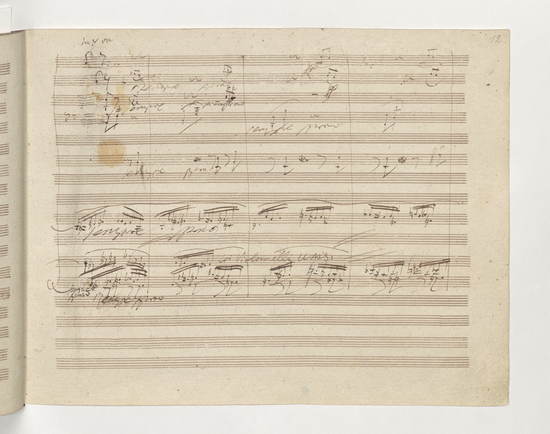Talk:Symphony No. 9 (Beethoven)
| This is the talk page for discussing improvements to the Symphony No. 9 (Beethoven) article. This is not a forum for general discussion of the article's subject. |
Article policies
|
| Find sources: Google (books · news · scholar · free images · WP refs) · FENS · JSTOR · TWL |
| Archives: 1, 2Auto-archiving period: 90 days |
| A fact from this article was featured on Wikipedia's Main Page in the On this day section on May 7, 2005, May 7, 2006, May 7, 2009, and May 7, 2016. |
| This It is of interest to the following WikiProjects: | |||||||||||||||||||||
| |||||||||||||||||||||
|
||
|
This page has archives. Sections older than 90 days may be automatically archived by Lowercase sigmabot III when more than 3 sections are present. |
 | This article was created or improved during WikiProject Europe's "European 10,000 Challenge", which started on November 1, 2016, and is ongoing. You can help out! |
Tippett Symphony No. 3[edit]
Would an experienced editor like to incorporate the fact below from the Tippett 3 article https://en.wikipedia.org/wiki/Symphony_No._3_(Tippett) into the Influences section of this article, alongside Dvorak and Bartok? It's quite a glaring omission. Also, Andriessen similarly quotes Beethoven 9 in his 'De negen symfonieën van Beethoven' (1970) for ice cream bell and orchestra - if that can be cited, that should be in here too.
192.76.8.92 (talk) 18:02, 11 May 2021 (UTC)
"The symphony is notable for its use of blues and its direct quotation of the opening of the finale of Beethoven's Ninth Symphony. The work criticises the ecstatic and utopian understanding of the brotherhood of man as expressed in the Ode to Joy and instead stresses man's capacity for both good and evil.[1] The work is consequently characterised by contrasting and conflicting parts, its overall design being "one massive antithesis".[2]
1. Matthews, p.93 2. Kemp, p.438
Matthews, David (1980). Michael Tippett: An Introductory Study. London: Faber. Kemp, Ian (1987). Tippett: The Composer and his Music. Oxford: Oxford."
A Commons file used on this page or its Wikidata item has been nominated for deletion[edit]
The following Wikimedia Commons file used on this page or its Wikidata item has been nominated for deletion:
Participate in the deletion discussion at the nomination page. —Community Tech bot (talk) 04:53, 6 January 2022 (UTC)
Featured picture scheduled for POTD[edit]
Hello! This is to let editors know that File:Ninth Symphony original.png, a featured picture used in this article, has been selected as the English Wikipedia's picture of the day (POTD) for May 7, 2024. A preview of the POTD is displayed below and can be edited at Template:POTD/2024-05-07. For the greater benefit of readers, any potential improvements or maintenance that could benefit the quality of this article should be done before its scheduled appearance on the Main Page. If you have any concerns, please place a message at Wikipedia talk:Picture of the day. Thank you! – Howard🌽33 20:05, 14 January 2024 (UTC)

|
|
The Symphony No. 9 in D minor, Op. 125, is a choral symphony, the final complete symphony by Ludwig van Beethoven, composed between 1822 and 1824. It was first performed in Vienna on 7 May 1824. The symphony is regarded by many critics and musicologists as a masterpiece of Western classical music. It is one of the best-known works in common practice music and one of the most frequently performed symphonies worldwide. Symphony No. 9 was the first example of a major composer scoring vocal parts in a symphony. In the 20th century, an instrumental arrangement of the chorus was adopted by the Council of Europe, and later the European Union, as the Anthem of Europe. This photograph displays page 12 of Beethoven's original manuscript and is currently held in the collection of the Berlin State Library. Manuscript credit: Ludwig van Beethoven
Recently featured:
|
- Selected anniversaries (May 2005)
- Selected anniversaries (May 2006)
- Selected anniversaries (May 2009)
- Selected anniversaries (May 2016)
- B-Class vital articles
- Wikipedia level-4 vital articles
- Wikipedia vital articles in Arts
- B-Class level-4 vital articles
- Wikipedia level-4 vital articles in Arts
- B-Class vital articles in Arts
- WikiProject Classical music compositions task force articles
- WikiProject Classical music articles
- B-Class Vienna articles
- Low-importance Vienna articles
- WikiProject Vienna articles
- Articles created or improved during WikiProject Europe's 10,000 Challenge

